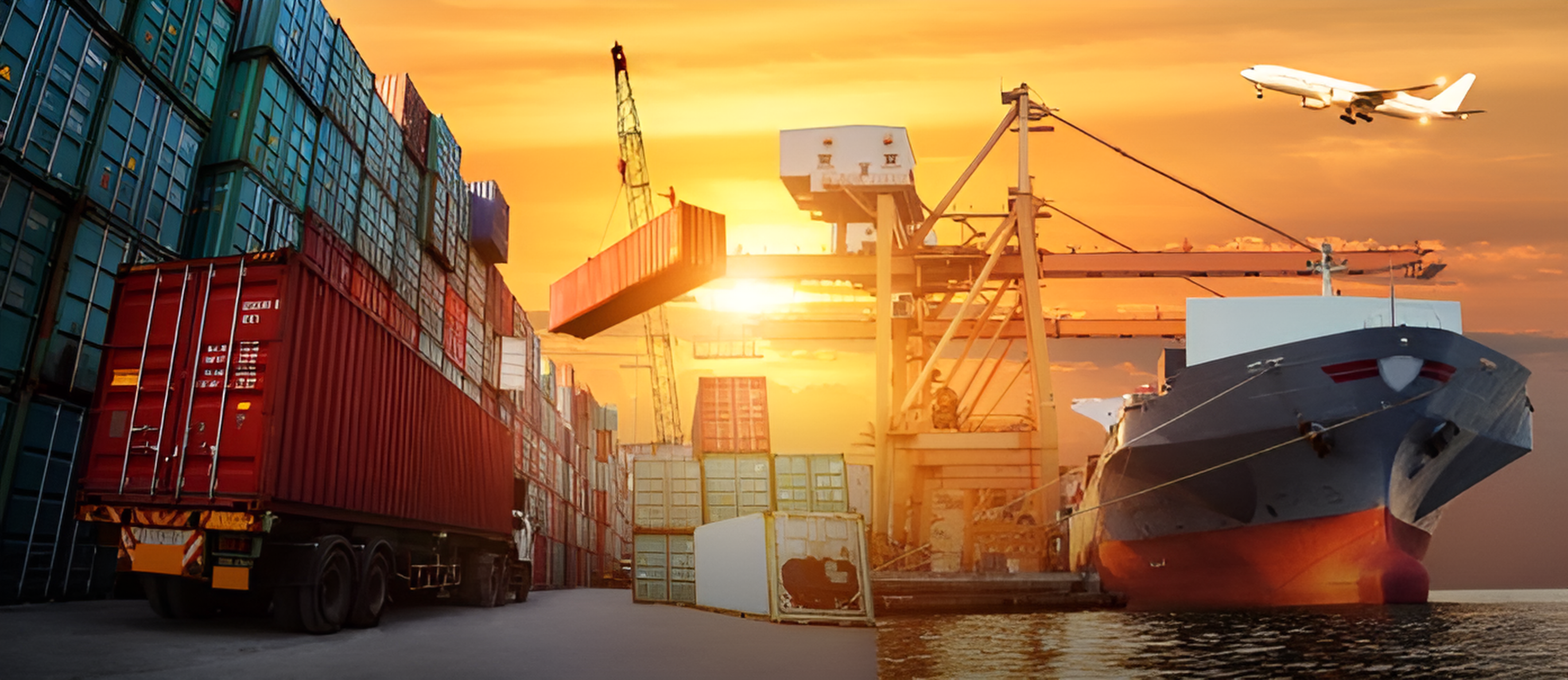Introduction
Trade routes have determined the economic strength of a country or empire for centuries. In the distant past the main trade routes crossed Eurasia on land (Silk Route) – the share of sea trade was less. Starting with the 15th century, the trade shifted clearly in favor of trading through the oceans. Naval dominance secured the global economic dominance of Europe by creating a colonial empire.
In the 20th century especially after World War 2, a bipolar world was created during the Cold war and a unipolar one after the fall of the Soviet Union. By late 21st century, due to the exceptional economic development of China that turned into a challenge to western hegemony, the Belt and Road Initiative (BRI) was launched by China aiming to engage more than 100 countries in Eurasia, Near East and Africa.
The West for the time being is continuing to control the international order, but the beginning of change towards a multipolar order are already visible. Planning to rebuild the ancient Silk Road since its independence China has taken concrete measures since the 1960s, starting for instance with the Karakoram Highway (KKH), Beijing has referred to the China-Pakistan Economic Corridor (CPEC) as ‘the fastest and most efficient’ of the BRI projects which gives Pakistan special importance. The goal of Beijing and Islamabad is that the infrastructure investment will deepen the political and economic ties between the two nations.
Global Power Shift from West to East
The current reshaping of the world is evident with the emergence of new centers of smaller powers in Asia, Africa and Latin America, which are often neglected in Europe and the West. Eurocentrism is dominating the world view; it takes western values as a triangulation point for analyzing worldwide developments. This approach accepts European and Anglo-American supremacy without question and tries to carry this supremacy to future generations. It is contested by multipolar Eurasianism, an approach open to both western and Asian values and serving as a nexus facilitating their healthy interaction (Tulun, 2022).
Europe connects with the rest of Eurasia, forms its western-most edge, and became a continent when the Ural Mountains were arbitrarily named the dividing line. Geopolitically, the importance of Europe and Asia is evident, as it has remained the center of power for centuries. Today the world is reshaping with a power transition led by Asian nations including China, Japan, the Association of Southeast Asia (ASEAN), Koreas, India, and some others. The last two decades have been a period of evolution and rise for many Asian countries, especially China. The economic, political, and military strength of China has made it an emerging superpower, undergoing structural adjustments in the global system with the declining powers of the U.S. The intellectual, cultural, and economic landscape coloured by Asian culture is reemerging; we are sighting the emblems of the world’s center of gravity shifting back to where it lay for millennia. For centuries, Asia has been the fountain of philosophical thought, ground of mighty empires, and home to rich resources and technology and has fed the imagination of the rest of the world.
The regional development of Eurasia and the BRI countries depends on the multilateral institutions that have been founded recently and have been continuously extending their membership and influence. They are working to boost economic, political and security-related cooperation. Russia’s realization of not being able to defeat the U.S. on its own has changed its political and military scenario in the last two decades. Russia has increasingly looked east and brought its relationship with China to a level never seen before. The Eurasian Economic Union (EAEU), the Association for Southeast Asia Nations plus China, Japan and South Korea (ASEAN+3), and the Brazil, Russia, India, China, and South Africa (BRICS). These institutions are key to the growing influence of Russia in not only the region but also the world. As an emerging superpower, China has enormous trade with both Russia and India and asserts the power concentration in different spheres within Eurasia.
China promotes the diversification of industrial production centers and accumulation with economic integration on a regional basis. It has also invested in new relationships of interdependence between nations, widening common interests, and opening avenues for cooperation. It believes that economic globalization is a major driver of political multipolarity. China continues to participate in international politics; its diplomatic policy shows commitment to both multilateralism and cooperative partnerships with major powers including the US. This cooperation is not contesting China’s self-reliance as Clegg (2009) discussed that China’s successful operation within international networks of interdependence, to initiate win–win agreements and to bargain over the rules of the global economy depends on its own self-reliance.
Pakistan and the West – The Future Aspect
Pakistan’s relationship with the West has increasingly become frosty for some time – be it the United States or Europe. This is neither new nor surprising, the West has been using our services and our socio-economic infrastructure (ports, roads, railways, trucks, etc.) as well as our military potential on a transactional basis mainly because our leaders miserably failed to secure our national interest and exploit our geopolitical positioning on a long-term basis. Once we have served their aims and objectives, we went back to being treated unfairly.
The intensification of competition of the West with the rising China and a resurging Russia gives opportunity for new coalitions and alignments. While establishing its intra-regional relations Pakistan must not overlook the importance of the West, which is still an economic hegemon, with 50% share in global Gross Domestic Product (GDP) in $ $94 trillion World Economy (Neufeld, 2021). Pakistan’s economic development must be the only focus of the government as it has no rational reason to compromise any of its relations (with the West or East) when its economy is in dire need of investments.
Pakistan and the United States (US)
Pakistan and the U.S. bilateral relations have seen many vicissitudes since 1947 and currently. the U.S. has once again commenced the debate on the role of Pakistan in the fight against terrorism.
The U.S. demand actions against United Nations (UN) designated terrorist organizations; the demand has been fulfilled by Pakistan in the form of National Action Plan (NAP) for countering terrorism. Concerns in the U.S. have been raised on Pakistan’s commitment and some officials want Washington to revisit its engagement with Islamabad (Mir, 2021). Whoever won in Afghanistan, we were always going to be the loser; the surprise is that this time it has taken so very little time for our Afghan brethren to target us, their main support during these last twenty years. However, there are signs that the US is looking at Pakistan as a deterrent for terrorists sponsored by, or given bases to operate, by the Taliban.
Still both countries are closely working in the areas of energy, trade and investment, health, climate change, and counterterrorism. The US has remained a big market for Pakistani exports – $5 billion export in the year 2021. It has remained a leading investor in Pakistan for the last 20 years.
With the CPEC, as a flagship project of BRI, Pakistan’s focus must be on its geo-economic situation. Our lies in geo-economics through increasing ties within the region whilst strengthening existing relationships with the US and Europe. The relationship between Pakistan and the U.S. will flourish only with a common vision of peace in South Asia and close economic cooperation.
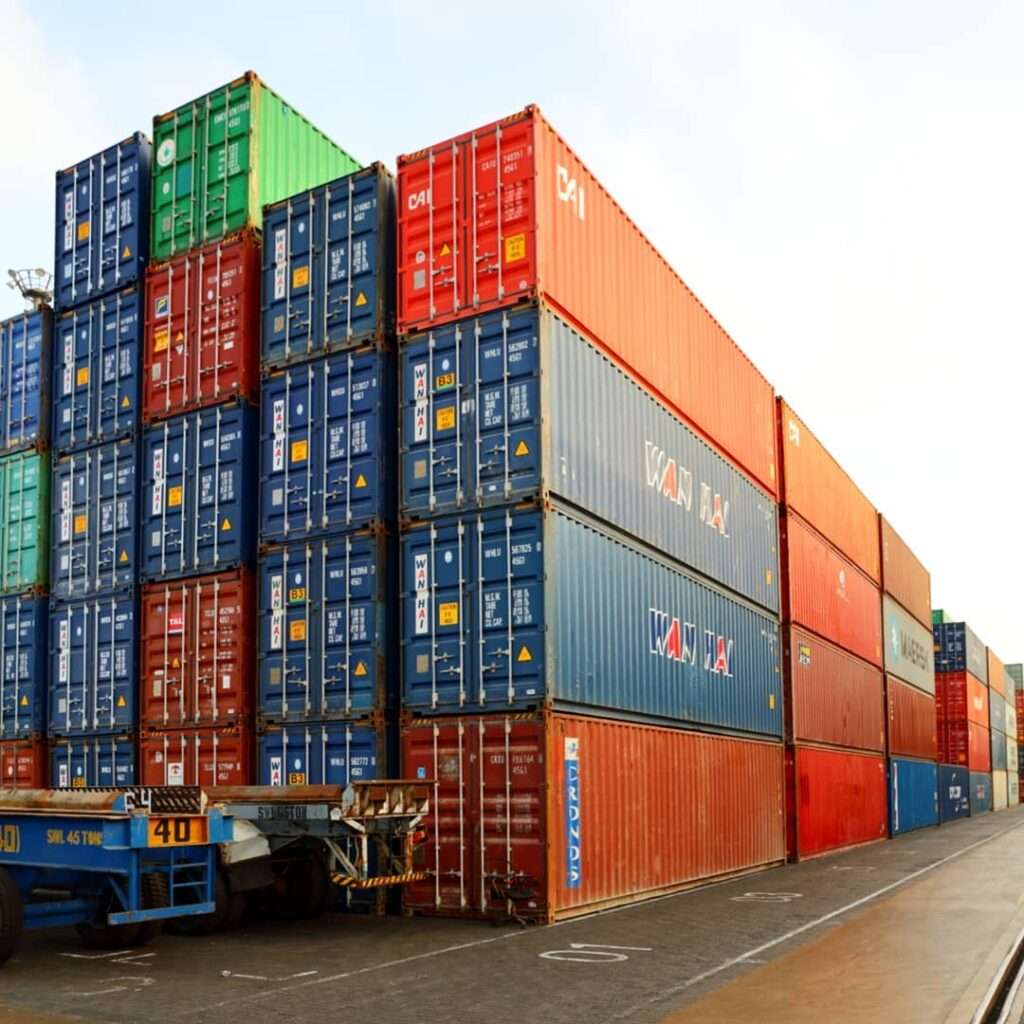
Pakistan and Europe
“The modern world, for better or worse, springs from Europe” (Marshall, 2016). This may change in the face of Europe’s faltering economy and de facto de-industrialization resulting from the backlash of sanctions that are meant to hit Russia are found to be also hitting Europe equally. In the long run, the nexus of Europe and Asia becomes more important as a safe trade route from Europe to the East.
Pakistan with its geographic location has land route access to Central Asia and sea routes to Europe, makes it a perfect country to channel trade routes and promote strong economic ties with Central Asia as well as Europe. In the year 2020 alone, Pakistan’s export in textile products to France was worth $639 million. Pakistan’s trade with the European Union (EU) and United Kingdom (UK) is enormous, with the GPS+ giving Pakistan preferential access to European markets. 76% of Pakistan’s exports, including textiles and clothing, enter the EU duty and quota free. This represents almost 20% of Pakistan’s exports globally (EU, 2021). Pakistan needs to strengthen and diversify bilateral trade and economic relations (other than textiles) with Europe in future as it has potential to develop strategically.
The UK has launched the Developing Countries Trading Scheme (DCTS) that provides tariff reductions and simpler terms of trade to 65 countries, including Pakistan (Zafar, 2022). It is recognized by both countries that the UK-Pakistan relationship matters. It is time to cement strong ties and increase bilateral trade.
Pakistan needs to not only improve transit facilities but encourage investment in exports’ industry to produce internationally competitive products. The geographical position of Pakistan is a blessing but geo-economics is the playbook, which can bring prosperity in Pakistan.
Pakistan – Russia Nexus
Relations between Russia and Pakistan in the past have been rather cool in every sphere i.e. politically, militarily and economically. The way forward for Russia and Pakistan in the present geopolitical circumstances is to develop strong economic ties with Asian countries for regional development. The region is re-shaping itself and Pakistan is in a position to play an important role as it has a geographic advantage over others. Russia after the Ukraine invasion is looking towards the southeast to increase sales to China and other Asian countries. Despite increasingly leaning to the US for trade, particularly military procurement India is openly purchasing Russian oil. Pakistan could also benefit from oil, petrol, and diesel purchases at discounted prices with Russia. In any case, Pakistan’s only option is to diversify its energy sources procurement for sustainable growth. For a 5% to 6% growth rate the energy requirement will increase from 8% to 10% every year, which is not possible with uncertain and expensive fuel supply (Abbas, 2022). Poverty alleviation and creation of jobs is possible only with economic growth, which requires uninterrupted energy supply. Pakistan can import fuel from Russia as the U.S. has already removed sanctions on Moscow to sell petroleum products to low- and middle-income countries. Pakistan is also in agreement to purchase wheat from Russia this year, the Economic Coordination Committee (ECC) of the Cabinet accepted import of 9,50,000 tons of wheat – 450,000 from Russia (Kiani, 2022).
Pakistan can shield itself from global price shocks and disruptions, by relying more on the Asian countries including Russia for development. In the last few years, diplomatic and military relations have also been improved and Russia can see the potential of Pakistan’s economy. Russia’s dream of land access to a warm water port had military connotations it failed. This Czarist desire can come true with economic connotations with Pakistan, similarly, access to central Asian markets and purchase of fuel from Russia can change the destiny of Pakistan. Shanghai Cooperation Organization (SCO) is a platform where Russia and China are developing consensus on the future of the region, now it is up to Russia to decide about future relationships with South Asian countries.
New Delhi shifting of military procurement to the US has made Russia build up its trade, military and political ties with Pakistan – as China’s lucrative CPEC project is moving Pakistan towards development. India and Pakistan have been fighting over Kashmir for decades; it has been damaging our trade and economic cooperation. It is time to resolve the matter according to the United Nations (UN) resolutions. This could be beneficial for all stakeholders in the region.
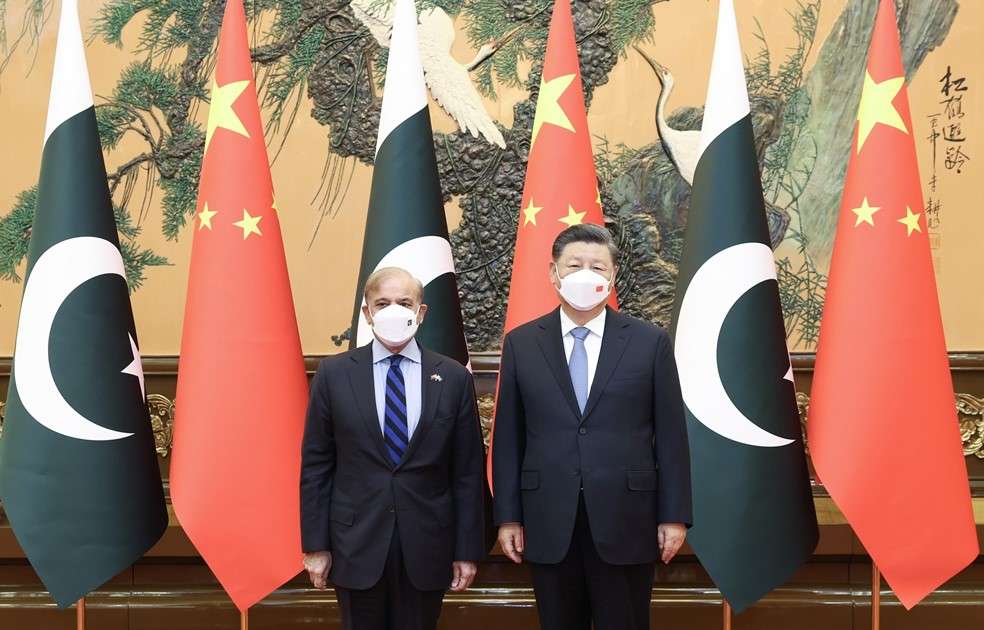
Strategic Partners: Pakistan and China
Pakistan and China are strategic partners and the relationship has been strengthening with CPEC as an essential segment of BRI. The relationship has been developed in the “1+4” cooperation mode: CPEC is prioritizing Gwadar, energy, transport, infrastructure, and industrial cooperation in Pakistan. In the11th meeting of Joint Cooperation Committee (JCC), both countries applauded the completion of energy projects and infrastructure including: 2×660 Mega Watt (MW) Port Qasim Power Plants, 2×660 MW Sahiwal Power Plant, 2×330 MW Engro Thar Power Plants; 50 MW Hydro China Dawood Wind Farm Thatta; 1000 MW Quaid e Azam Solar Park, Bahawalpur, Karakoram Highway (KKH) Phase II (Havelian – Thakot Section), Peshawar-Karachi Motorway (Multan-Sukkur Section), Hakla – D.I Khan Motorway and Orange Line Metro Train – Lahore. These projects are significant for providing a myriad of opportunities for socio-economic development in Pakistan. It was also decided to start the ML-1 project that includes up-gradation and doubling of Main Line-1 (ML-1) from Karachi to Peshawar and Taxila to Havelian (1733 km). It is also proposed to initiate cooperation and China’s investment in the post disaster reconstruction, global development initiatives, strengthening of digital investment in the economy, 1+5 arrangements for SEZs, agreement between geological survey institutions of the two countries, and support to increase export potential of Pakistan(JCC, 2022).
Both countries, as members of multilateral organizations are determined to work for peace and stability in the region. In the last five years, the volume of bilateral trade has increased with the annual growth rate of 18.8% on average, bilateral investment has been high and China has become one of the biggest sources of foreign capital.
Pakistan: A Significant Player on the Eurasia Chessboard
With its geographic position the geopolitical and geostrategic position of Pakistan has made it a key player in the development of the region. As an emerging superpower, China continuously emphasizes CPEC as its connection to the world. This is time for Pakistan to start working on emergency footing to solve its internal issues – law and order, security, political stability, current account deficit, favorable environment for investment – and concentrate on economic revival, especially by focusing on underprivileged Baluchistan for maximum development and engaging media and other stakeholders to promote and protect interest of Pakistani people in CPEC project. This is also inevitable for regional development as Pakistan is situated in the heart of Asia where it is bordering with People’s Republic of China (PRC), Afghanistan, India, and Iran while Tajikistan is separated by a thin Wakhan Corridor only. It was part of the ancient silk route and the tribes on the border of China, Tajikistan, Afghanistan and Pakistan used to trade with each other till the Soviet invasion of Afghanistan. The route between Wakhan and Hunza survived due to trails like Irshad Pass (elevation 16,300 feet, a part of the ancient Silk Road trade network). It will be useful to utilize more of the Tajikistan route because we share the same culture, language and kinship – an additional advantage (Dawn, 2018).
For Pakistan, it is time to connect more within the region for development as the power dynamics is shifting from West to East. The development of Pakistan and contribution in the region’s stability are through Sino-Pak strong trade and economic cooperation. Transportation of Iranian and Caspian Sea oil up through Pakistan to China is another source of income (Marshall, 2016). The regional geopolitical scenario is complex and Pakistan is in a good bargaining position with China for the following reasons: the Ukraine-Russian war and its outfall, the future of Turkiye after the lapse of the Treaty of Lausanne in 2023, the Malacca Straits dilemma and Sino-Indian rivalry.
Gateway Asia (Karachi and Gwadar) to Gateway Europe (Le Havre)
India’s continued attempt at the diplomatic isolation of Pakistan has had enormous repercussions. Denying our land access to South Asia and Southeast Asia cuts both ways, it also has negative connotations for India, which in turn means India is deprived of access to Central Asia, Middle East and Europe as well as southwestern China through Pakistan. This is the right time to refocus on the BRI’s Central Asia-West Asia corridor. The cheapest and easiest way is the maritime route, as South Asian trade through the Indian Ocean Region (IOR) is both west and east bound: west to the economies of the Middle East, Africa and Europe, and east to ASEAN and the economies of the Asia-Pacific. Importance of CPEC and ports of Pakistan has increased now as China is facing troubles in the BRI projects, which have been extended to almost 70 countries.
China is relying on CPEC connecting Kashgar to Karachi and Gwadar through a road and railway network and the maritime route to Europe. This gives China direct land access to the Arabian Sea and the Indian Ocean as the port of Gwadar has been developed into South Asia’s largest port, avoiding the Malacca Strait chokepoint, through which the majority of China’s imports of crude oil currently travel. With the help of this corridor, China will also find it simpler to market its products to Pakistan’s expanding middle class and beyond.
The maritime Silk Road runs with its links from the Chinese coast to the south via Hanoi to Jakarta, Singapore and Kuala Lumpur through the Strait of Malacca via the Sri Lankan Colombo opposite the southern tip of India via Malé, the capital of the Maldives, to the East African Mombasa, from there to Djibouti, then through the Red Sea over the Suez Canal into the Mediterranean, there via Haifa, Istanbul and Athens to the Upper Adriatic and to the northern Italian junction of Trieste with its international free port and its rail connections to Central Europe and the North Sea. The most feasible route available to China is through ports of Pakistan to Africa, and Europe (see Figure 1).
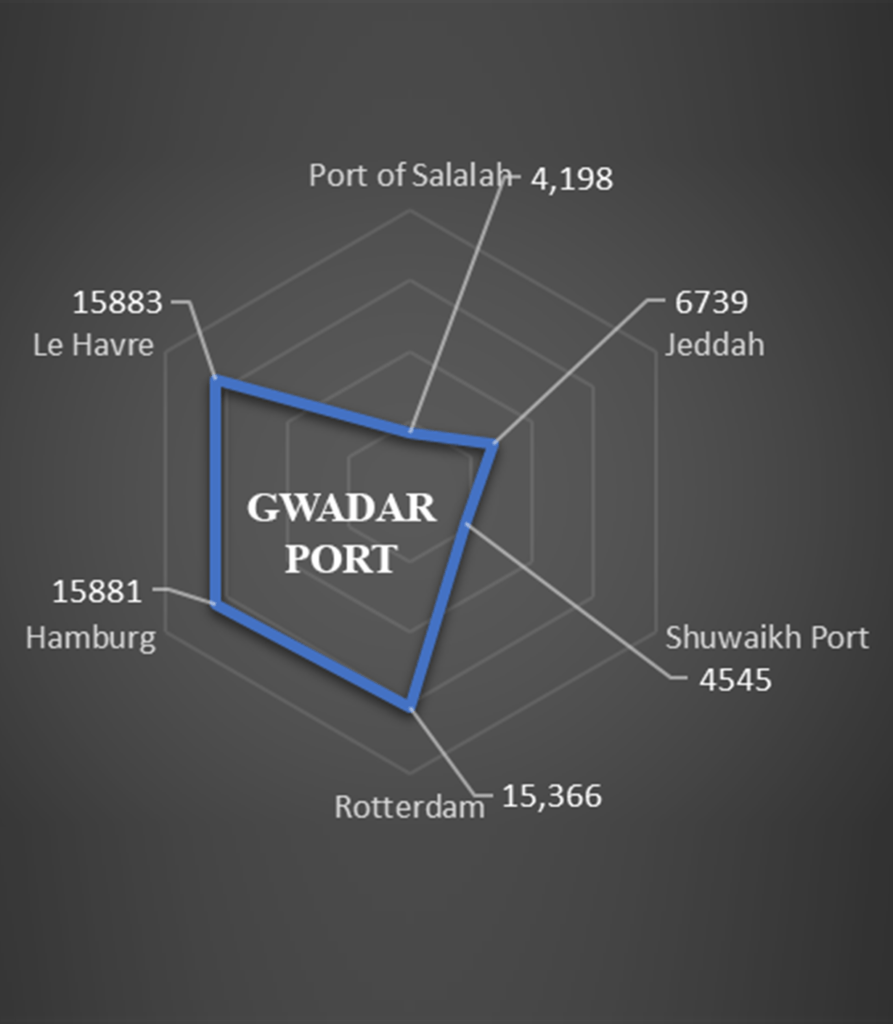
Source: Author’s contribution
Due to the Malacca dilemma, Turkiye’s uncertain future, Sino-India rivalry and the Russian invasion in Ukraine, it is problematic for China to use these routes and continue related projects. The sustainable and feasible option is the CPEC land route from central Asia to Bin Qasim port, Karachi port and Gwadar port. The sea route from Gwadar to Le Havre port is the shortest as the land distance from Kashgar (China) to Gwadar(Pakistan) is 2800 km and the total distance Kashgar-Le Havre is 15,883 km. The sea route is accessible for China due to its rising presence in the Indian Ocean (See Figure 2).
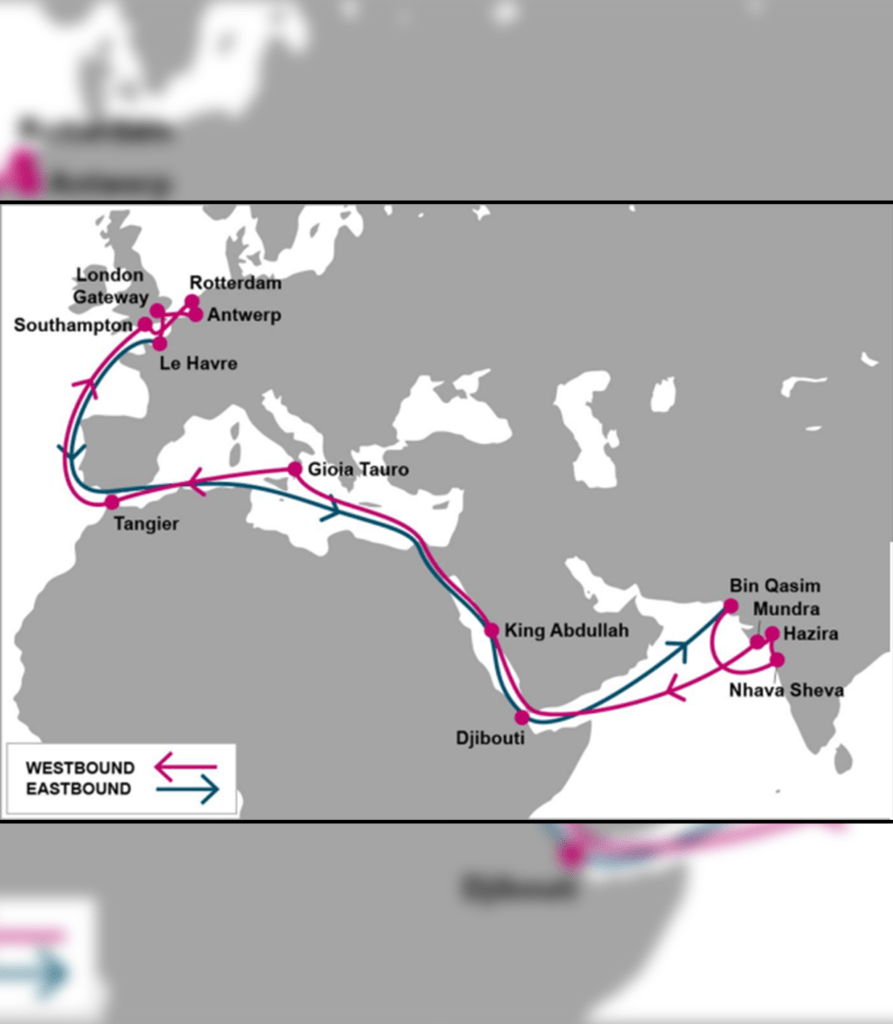
Source: Ocean Network Express (ONE).
China is building military control in the Indian Ocean Region (IOR) to project its maritime power. It includes docking rights and operational rights at ports, multi-year leasing of ports and establishment of foreign bases (military). China has presence in the following ports – mainly declared to be used for economic and commercial purposes: Kyaukpyu in Myanmar, Hambantota in Sri Lanka, Feydhoo Finolhu in the Maldives, Gwadar in Pakistan and Obock in Djibouti. In 2017, Beijing set up its first overseas military facility in Djibouti (Africa) on the Indian Ocean coast whereas France, Japan, and the United States also have facilities in Djibouti.
Central IOR–South Asia trade through the IOR reaches all the way from Chinese ports to the Mediterranean Sea, but sea-lanes have also been affected by serious delays. Pakistan with CPEC and maritime sea route provides a unique opportunity for China to connect to the Middle East, Africa and Europe. The railway and road network between landlocked Central Asia and Pakistan can be a game-changer for these Central Asian countries. Pakistan – Tehran – Istanbul railway network is another option which can connect China to Europe. Security issues of Turkiye after the end of treaty of the Treat of Lausanne in 2023 will change the role of China. Pakistan, having ties with Turkiye and China both, can play a bridging role between the two countries. Economic and strategic relations between China and Turkiye will bring prosperity in the region.
Pakistan and Central Asia
Central Asian landlocked countries can utilize Pakistani seaports to reach Europe, Africa, Middle East – the most economic and efficient route. Currently, central Asian countries rely on sea ports in China, Turkey, Iran, Russia and the Baltic States. Regional development can also enhance trade and economic ties between Pakistan and Central Asian countries including Tajikistan. There were two declarations made in the year 2017-18, between Tajikistan and Pakistan: one is, ‘Road to strategic partnership for regional solidarity’ and the other one, ‘Strengthening the road to strategic partnership for regional integration’. Pakistan has been supporting a membership of Tajikistan in the Quadrilateral Traffic in Transit Agreement (QTTA), also reiterating to increase the cooperation in future for global and regional peace and development (APP, 2021).
QTTA provides Pakistan a gateway to Central Asia by using the Karakoram Highway – which links Gilgit-Baltistan to China’s Xinjiang region – as a transit corridor. If Afghanistan fails to provide a safe trade route to Pakistan then this road network with Tajikistan, China, Kyrgyzstan and Kazakhstan will serve the purpose of connecting to Central Asia. The route is as follows: Karachi-Rawalpindi-Hassanabdal-Gilgit-Khunjerab, (Pakistan-China Border)-Kashgar-Torugart(China and Kyrgyzstan Border)-Bishkek-Akjol-Kordai (Kyrgyzstan/ Kazakhstan Border)-Almaty (Kazakhstan) = Length – 3710 Km (Shoaib, 2016). It is an alternative route if Afghanistan insist on India’s inclusion in the Afghan-Pakistan road network, Afghanistan-Pakistan Transit Trade Agreement (APTTA) is a successor to the Afghanistan Transit Trade Agreement (ATTA) signed in 1965 between Pakistan and Afghanistan to facilitate the transit of goods exported from and imported to Afghanistan using the Pakistani port of Karachi.
The current agreement permits the use of more ports and more carriers – including Afghan trucks – and increases the number of border crossing points. It also provides for Afghan exports to India using the land border between Pakistan and India. The pact also envisages the use of Afghan territory for trade between Pakistan and Central Asian countries (UNCTAD, 2011).
The route bypassing Afghanistan will be helpful, as China will have to deal with just one country (Pakistan) to access other regions (See Figure 3).
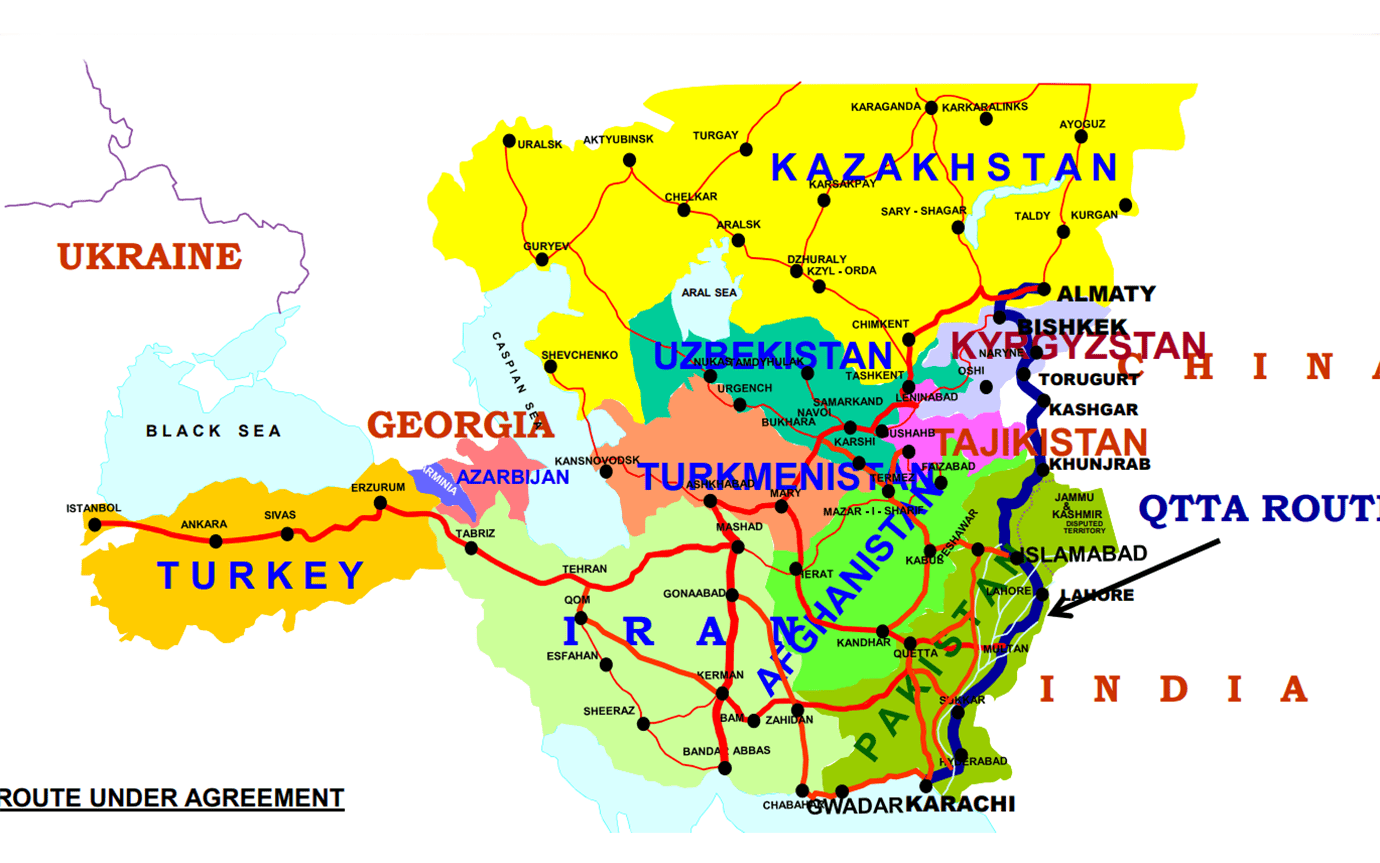
Source: Ministry of Communication, Government of Pakistan.
Conclusion
Regional development after the global power shift lies in the core of Asia, the importance of CPEC and China’s connectivity to the world through Karachi, Bin Qasim, and Gwadar ports has been manifold during the last year in the face of the Russia-Ukraine war. Pakistan must look forward to regional partners for economic and social development. Spillover of CPEC will bring prosperity to underprivileged areas. The future lies in regional development. Road and railway networks under CPEC including ML1, ML2, and ML3 must be upgraded. A railway track parallel to KKH will decrease the travel time and increase trade benefit.
The future of Pakistan is in the blue economy. Pakistan has about 990 km long coastline, an exclusive economic zone of 240 000 sq. km, and an additional continental shelf area of about 50,000 sq. km, making Pakistan an important coastal state. The exclusive geostrategic position of Pakistan provides its ports a unique importance for maritime trade. Furthermore, the construction of Gwadar as a transit and transshipment port under CPEC has further enhanced Pakistan’s potential to play a significant role in the Indian Ocean Region.
Pakistan has enormous potential in a blue economy as it can serve as a viable and the most effective economic transit route to land-locked Central Asia and neighboring countries. The Karachi Port Trust (KPT) and the Port Qasim Authority contribute more than Rs. 20 billion per year. The maritime economy is an important pillar of economic structure, which can bring good economic return if the port capacities are enhanced, ease of doing business, good governance, and secure investment and trade environment, transshipment, ship maintenance, ship building and digitalization of ports are developed.
CPEC is an opportunity to increase our economic activity and build a working relationship with neighboring countries. It is suggested to devise a regulatory mechanism for CPEC and it should be completely in favor of the government of Pakistan – inclusive growth with special attention to the people of Baluchistan. Connectivity through roads and railway networks within the region and ports at the Arabian Sea for global trade are present, both land and sea routes are available. India and Pakistan must build a better working relationship – intact sovereignty for both countries – for their prosperity. There is a dire need to minimize conflicts and security concerns with India, Afghanistan and Iran for the greater regional interest. India will not be able to contest the massive blue water navy, which China is planning.
(The author acknowledges with gratitude research and assistance from Dr. Bettina Robotka, Col (Retd) Hassan Raza and Sehrish Mustafa)
Bibliography
• Abbas, Z. (Ed.). (2022, 127). Fuel from Russia. Dawn. Retrieved from https://www.dawn.com/news/1725107/fuel-from-russia
• Agnihotri, G. C. (2022). Shared Situational and Domain Awareness as an Initial Framework for Strengthening the Quadrilateral Security Dialogue. Journal of Indo-Pacific Affairs.
• APP. (2021). Pakistan, Tajikistan reiterate to further strengthen multilateral cooperation. Pakistan: Digital Associated Press of Pakistan. Retrieved from https://www.app.com.pk/national/pakistan-tajikistan-reiterate-to-further-strengthen-multilateral-cooperation/
• Brzezinski, Z. (1997). The Grand Chessboard: American Primacy and Its Geostrategic Imperatives. Basic Books.
• Casey, J. (2019, September). Into Africa: the US’ drive for African rare earth minerals. Mining Technology .
• Clegg, J. (2009). World, China’s Global Strategy: Towards a Multipolar World. Pluto Press. Retrieved from https://doi.org/10.2307/j.ctt183p561
• Clinton, H. (2012, December 6). Clinton Vows to Thwart New Soviet Union. (C. Clover, Interviewer) Financial Times. Retrieved from https://www.ft.com/content/a5b15b14-3fcf-11e2-9f71-00144feabdc0
• Dawn. (2018, February 9). Centuries on, barter trade through Wakhan corridor continues. Islamabad, Pakistan.
• EU. (2021). EU trade relations with Pakistan. European Commission.
• Fanell, J. (2019). China’s Global Naval Strategy and Expanding Force Structure, Pathway to Hegemony. Naval War College Review, 72(1).
• Fernandez, A. M. (2022, June). Pakistan and France: A positive U-turn. DAWN.
• Frankopan, P. (2015). The Silk Roads: A New History of the World. Bloomsbury.
• Green, M. (2022, 8 November). In the Months Since Russia’s Brutal Invasion of Ukraine, Its Trade With China Has Surged. Wilson Center.
• JCC. (2022). The Meeting of 11th Joint Cooperation Committee (JCC) of China Pakistan Economic Corridor (CPEC). Islamabad. Retrieved from https://www.cpec.gov.pk/news/229
• Jeudy, L. (2022, June). Proportion of Muslims among the population of France according to the French 2018. Statista.
• Judson, J. (2022). China Naval Modernization: Implications for U.S. Navy Capabilities. Congressional Research Service.
• Kiani, K. (2022, December 6). Pakistan approves deal to import 300,000 tonnes of Russian wheat. Dawn.
• Long Term Plan for China-Pakistan Economic Corridor (2017-2030). (2017). Islamabad, Pakistan.
• Maçães, B. (2018). The dawn of Eurasia: on the trail of the new world order. Yale University Press.
• Marshall, T. (2016). Prisoners of Geography. London: Eliiott and Thompson Limited.
• Mir, N. A. (2021). Issues and mistrust in US-Pakistan relations. Atlantic Council, Washington. Retrieved from https://www.atlanticcouncil.org/blogs/southasiasource/issues-and-mistrust-in-us-pakistan-relations/
• Neufeld, D. (2021, December). Visualizing the $94 Trillion World Economy in One Chart. Vancouver, Canada.
• New UK Trade Scheme Paves the Way for an Increase in Pakistani Exports. (2022, August 17). Retrieved from https://www.gov.uk/government/news/new-uk-trade-scheme-paves-the-way-for-an-increase-in-pakistani-exports
• Pardesi, M. (2021). Explaining the asymmetry in the Sino-Indian Strategic Rivalry. Australian Journal of International Affairs, 35(6), 341-365.
• Ross, E. G. (2002). The Portuguese in Africa, 1415–1600. Heilbrunn Timeline of Art History. New York: The Metropolitan Museum of Art.
• Sharma, S. (2021). The 16+1 Initiative: Judged Too Quickly? New Delhi: Observer Research Foundation.
• Shoaib, M. (2016). Progress on Re-Booting Quadrilateral Agreement on Traffic in Transit. Islamabad: Ministry of communication, Government of Pakistan.
• Standard Chartered. (2019, january 3). Retrieved from Standard Chartered: https://www.sc.com/en/feature/one-masterplan-six-corridors/
• Tae-Woo, P., Patrick, K., Cullinane, B., & Lee, J. S. (2018). The 21st century Maritime Silk Road: challenges and opportunities for transport management and practice. 30-40.
• The Economic Times. (2022). Retrieved from m.economictimes.com: https://m.economictimes.com/news/economy/foreign-trade/india-australia-free-trade-agreement-to-come-into-force-from-december-29/articleshow/95879168.cms
• Toffler, A. (1991). Powershift: Knowledge, Wealth, and Violence at the Edge of the 21st Century. London: Bantam Press.
• Tulun, T. E. (2022). Eurocentric Supremacist Dependency and Eurasia Concept. Social Science Research Network. Retrieved from https://papers.ssrn.com/sol3/papers.cfm?abstract_id=4232540
• (2022). U.S. Relations with Pakistan. U.S. Department of State.
• UN. (2022). World Population Prospects 2022. New York: Department of Economic and Social Affairs, United Nations.
• UNCTAD. (2011). UNCTAD-supported Afghanistan-Pakistan transit trade agreement to take effect on 14 February. United Nations Conference on Trade and Development, Geneva.
• Zafar, T. (2022, August 29). UK includes Pakistan in New trading scheme: President British Pak Friendship Council. Pakistan News International.


